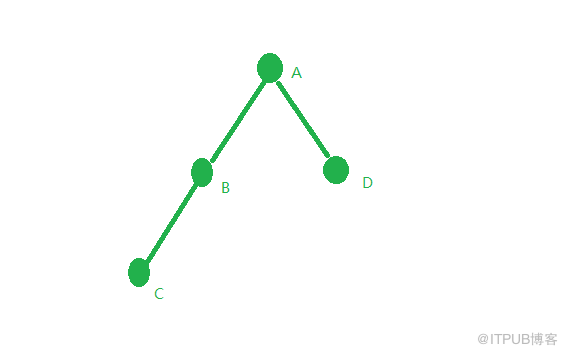前面一篇介绍了二叉树的递归遍历操作
http://blog.itpub.net/29876893/viewspace-1841619/,下面介绍二叉树的非递归遍历操作。
运用递归操作,很容易进行二叉树的遍历,结合上篇文章的介绍,在递归的时候都是找到当前结点,压入”栈“中,然后再通过当前结点找到左(右)孩子,递归函数每次返回时,当前结点都会出”栈“。在非递归遍历时,那就构造一个栈,用来存取每个结点的指针,通过该结点找到(左)右孩子,思路是有了。
下面结合下图简单的说明一下:
 前序遍历:
前序遍历:
首先A,B,C依次入栈,然后由于C->lchild为空,所以返回到结点C,遍历其右孩子C->rchild,但是也为空,此时C出栈,遍历B结点的右孩子,为空,B出栈,返回到A,A出栈,遍历A结点的右孩子,打印D的数据域,D进栈,遍历D的左孩子,为空,D出栈,遍历D的右孩子,为空,此时栈也空,该循环结束。
中序遍历:
首先A,B,C依次入栈,然后由于C->lchild为空,所以返回到C,打印C结点的数据域,然后遍历C->rchild,由于为空,C出栈,返回到B,打印结点B的数据域,然后遍历B->rchild,由于为空,B出栈,返回到A,A出栈,打印结点A的数据域,然后遍历A->rchild,不为空,然后遍历D->lchild,为空,返回到D,D出栈,打印D结点的数据域,然后遍历D->rchild,由于为空,此时栈为空,循环结束。
后序遍历:
A,B,C依次入栈,第一次遍历这些结点时,设置了标记,都为0.然后遍历C->lchild,为空,此时返回C,设置标记为1,然后访问C->rchild,由于为空,此时C出栈,打印了C结点的数据域。下面也是这样分析,由于过程复杂,读者可以自己分析,这里不作赘述。
下面给出上述的实现代码:
运行结果:

运用递归操作,很容易进行二叉树的遍历,结合上篇文章的介绍,在递归的时候都是找到当前结点,压入”栈“中,然后再通过当前结点找到左(右)孩子,递归函数每次返回时,当前结点都会出”栈“。在非递归遍历时,那就构造一个栈,用来存取每个结点的指针,通过该结点找到(左)右孩子,思路是有了。
下面结合下图简单的说明一下:

首先A,B,C依次入栈,然后由于C->lchild为空,所以返回到结点C,遍历其右孩子C->rchild,但是也为空,此时C出栈,遍历B结点的右孩子,为空,B出栈,返回到A,A出栈,遍历A结点的右孩子,打印D的数据域,D进栈,遍历D的左孩子,为空,D出栈,遍历D的右孩子,为空,此时栈也空,该循环结束。
中序遍历:
首先A,B,C依次入栈,然后由于C->lchild为空,所以返回到C,打印C结点的数据域,然后遍历C->rchild,由于为空,C出栈,返回到B,打印结点B的数据域,然后遍历B->rchild,由于为空,B出栈,返回到A,A出栈,打印结点A的数据域,然后遍历A->rchild,不为空,然后遍历D->lchild,为空,返回到D,D出栈,打印D结点的数据域,然后遍历D->rchild,由于为空,此时栈为空,循环结束。
后序遍历:
A,B,C依次入栈,第一次遍历这些结点时,设置了标记,都为0.然后遍历C->lchild,为空,此时返回C,设置标记为1,然后访问C->rchild,由于为空,此时C出栈,打印了C结点的数据域。下面也是这样分析,由于过程复杂,读者可以自己分析,这里不作赘述。
下面给出上述的实现代码:
点击(此处)折叠或打开
- #include<iostream>
- #define MAX_SIZE 20
- using namespace std;
- typedef struct TreeNote {
- char ch;
- struct TreeNote *lchild, *rchild;
- }*BiTree;
- typedef struct Stack {
- BiTree data[MAX_SIZE];
- int top;
- };
-
- void createBiTree(BiTree &bt) {
-
- char chh;
- cin >> chh;
- if (chh == '#')
- bt = NULL;
- else {
- bt = new TreeNote;
- bt->ch = chh;
- createBiTree(bt->lchild);
- createBiTree(bt->rchild);
- }
- }
- void initStack(Stack *&st) {
- st = new Stack;
- st->top = -1;
- }
- bool emptyStack(Stack *st) {
- return st->top == -1;
- }
- bool fullStack(Stack *st) {
- return st->top == MAX_SIZE - 1;
- }
- void pushStack(Stack *st, BiTree bt) {
- if (!fullStack(st))
- st->data[++st->top] = bt;
- else
- cout << "栈已满!" << endl;
- // exit(-1);
- }
- BiTree pop(Stack *st) {
- if (!emptyStack(st)) {
- return st->data[st->top--];
- }
- else
- return NULL;
- }
- BiTree getpop(Stack *st) {
- if (!emptyStack(st)) {
- return st->data[st->top];
- }
- else
- return NULL;
- }
- void preOrderTree(BiTree bt) {
- Stack *st;
- initStack(st);
- BiTree p;
- p = bt;
- while (p != NULL || !emptyStack(st))
- {
- while (p != NULL)
- {
- cout << p->ch << " ";
- pushStack(st, p);
- p = p->lchild;
- }
- if (!emptyStack(st))
- {
- p = pop(st);
- p = p->rchild;
- }
- }
- }
- void InOrderTree(BiTree bt) {
- Stack *st;
- initStack(st);
- BiTree p;
- p = bt;
- while (p != NULL || !emptyStack(st)) {
- while (p != NULL) {
-
- pushStack(st, p);
- p = p->lchild;
- }
- if (!emptyStack(st)) {
- p = pop(st);
- cout << p->ch << " ";
- p = p->rchild;
- }
- }
- }
- void postOrderTree(BiTree bt)
- {
- BiTree p;
- Stack *st;
- initStack(st);
- p = bt;
- int flag[20];
- while (p != NULL || !emptyStack(st))
- {
- while (p != NULL)
- {
- pushStack(st, p);
- flag[st->top] = 0;
- p = p->lchild;
- }
- while (!emptyStack(st) && flag[st->top] == 1)
- {
- p = pop(st);
- cout << p->ch << " ";
- }
- if (!emptyStack(st))
- {
- flag[st->top] = 1;
- p = getpop(st);
- p = p->rchild;
- }
- else break;
- }
- }
- int main() {
- TreeNote *bt;
- cout << "please input some values:" << endl;
- createBiTree(bt);
- cout << "preOrderTree:" << endl;
- preOrderTree(bt);
- cout << endl;
- cout << "InOrderTree:" << endl;
- InOrderTree(bt);
- cout << endl;
- cout << "postOrderTree:" << endl;
- postOrderTree(bt);
- cout << endl;
- }

来自 “ ITPUB博客 ” ,链接:http://blog.itpub.net/29876893/viewspace-1848850/,如需转载,请注明出处,否则将追究法律责任。
转载于:http://blog.itpub.net/29876893/viewspace-1848850/




 本文介绍了二叉树的非递归遍历方法,包括前序、中序和后序遍历,并提供了详细的算法步骤及实现代码。
本文介绍了二叉树的非递归遍历方法,包括前序、中序和后序遍历,并提供了详细的算法步骤及实现代码。
















 5万+
5万+

 被折叠的 条评论
为什么被折叠?
被折叠的 条评论
为什么被折叠?








